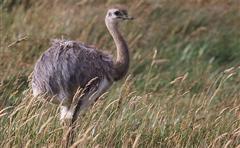Rhea - Lesser
Darwin's Rhea Scientific Name: Pterocnemius pennata
Sun, 6th July, 2025 - 4:06 am GMT
Sponsor Ads:

Alternative Name
Darwin's Rhea Scientific Name: Pterocnemius pennataBasic Info
Because it closely resembles the ostrich, though in greatly reduced proportions, the Lesser Rhea is sometimes called the South American Ostrich. Usually, they are between 35 inches (92 and 100 centimeters) long at maturity, and weigh about 22 pounds (between 10 and 25 kilograms). They are usually meatier than Common Rheas when body weight is compared to size. Lesser Rheas have large nails on each of their three toes. Their brown or golden brown plumage is soft and appears fluffy, though each feather is smooth. White speckles are sprinkled throughout the Lesser Rhea's coloration, though females often have fewer white spots than males. The head and neck are covered in shorter, contour feathers. Juveniles usually do not have any white coloring, which they will acquire when they are between three and four years old.
Health
Lesser Rheas should not be overcrowded. They are social animals and may be uncomfortable if kept alone. Lesser Rheas can tolerate colder climates than Common Rheas. They often become territorial around breeding season, when males may have to be isolated. In captivity, Lesser Rheas are fed standard ratite chow and fresh graze. They are allowed oyster shell to fulfill their grit requirements. Insects may be offered as a treat. Breeding Lesser Rheas reach sexual maturity when they are between two and three years of age. Male Lesser Rheas will establish a territory when they are ready to breed, usually between September and December. The males will build nests in these ranges by making scrapes in the ground and lining them with vegetation. Then, they "herd" females into it by running at them with their wings spread. Using this courtship ritual, they will usually accumulate between two and 12 females. After this, the next phase of courtship begins in which the male runs around the females in a circle and utters a range of vocalizations. After mating has occurred, the herd of females is led to a nest, where they will return every two or three days to deposit eggs. Each egg begins a green color, although this color will fade as the egg ages. The female Lesser Rheas will leave the area after they have deposited all their eggs. They will probably mate with other males before the breeding season is over. The male Lesser Rhea incubates the eggs for 35 to 40 days, usually starting between two and eight days after the eggs were deposited. At this point he will become highly territorial and will not even allow females intending to lay more eggs to come near the nest. These females lay their eggs nearby and the male rolls the eggs that come closest to the nest inside. Others will rot and attract insects that feed the male and the chicks that will hatch. An average clutch contains between 13 and 30 eggs. The first chicks' calls stimulate the other eggs to hatch, and within 48 hours the entire clutch will have hatched. Lesser Rhea chicks are feathered in grayish brown colored plumage. Most have blackish stripes. The male leads the Lesser Rhea chicks away from the nest to forage when they are a few days old, and the family maintains contact through vocalizations. Males are very protective of the brood and will often adopt any chicks that stray into the area. They continue to care for the brood for about six months. However, flocks may remain together until the young Lesser Rheas reach sexual maturity.Habitat
These birds are found mostly in open steppes or grassland, though they have also been found in scrub forests.Behavior
Although the Lesser Rhea is lesser in size than the Common Rhea, these birds have equally interesting habits and are equally as beautiful as their larger counterparts. Sociable animals, Lesser Rheas are often found in flocks containing between 5 and 30 birds. They do require a bit of individual space, and when birds come into close contact, they may thrust their heads forward and hiss at each other to establish distance. During the breeding season, flocks usually break up when male Lesser Rheas become territorial. Lesser Rheas are usually active during the day, save during the hotter months of the year. Oddly enough, Lesser Rheas sometimes ingest pebbles with no apparent ill effects. They also eat insects and small animals on occasion, though the majority of their nutrition comes from plant material. Most of the water consumed by the Lesser Rhea is also absorbed from this food. Able to run at speeds more than 60 kilometers per hour, Lesser Rheas are also good swimmers. Predator avoidance tactics are strategic; Lesser Rheas will often redouble during pursuits and squat low to the ground, hiding. They also run, turning at sharp zigzagging angles through the forest, for short distances.Origin
South AmericaHistory
Darwin's Rhea, or the Lesser Rhea, is native to South America. They range through Patagonia, Peru, Bolivia, Chile, and Argentina. Lesser Rheas are sometimes grazed with livestock to remove burrs or seeds from wool. Sadly, they are disappearing, due to over-hunting for meat, feathers, and eggs. In most of their range, Lesser Rheas are threatened or endangered.Common Foods
meat, feathers, and eggsSponsor Ads:
John Cameron's Law: No matter how many times you've had it, if it's offered, take it, because it'll never be quite the same again.
Rhea - Lesser
Coded by: BGID® | ALL RIGHTS RESERVED Copyright © 2000-2025
Disclaimer | Privacy | Report Errors / Contact | Credits








 President of the United States of America - Real Estate mogul, Pageant owner and now one of the most controversial men in political history.
President of the United States of America - Real Estate mogul, Pageant owner and now one of the most controversial men in political history.  Global warming has been in and out as the "latest" hot topic for many years. It is, according to modern scientists, the result of man-made industrial pollutants, clearing forested areas, agriculture, etc. But now they are thinking it started way before the Industrial Revolution...
Global warming has been in and out as the "latest" hot topic for many years. It is, according to modern scientists, the result of man-made industrial pollutants, clearing forested areas, agriculture, etc. But now they are thinking it started way before the Industrial Revolution...  Politician, US Vice President and President of the USA - Joseph Robinette Biden Jr.
Politician, US Vice President and President of the USA - Joseph Robinette Biden Jr.  versus
versus  Russia: 'The Evil Empire'? Are they all that bad or is it just the USA trying to portray Russia as bad because they are a world power with land bigger and a society very different from the USA ideal?
Russia: 'The Evil Empire'? Are they all that bad or is it just the USA trying to portray Russia as bad because they are a world power with land bigger and a society very different from the USA ideal? 
 Corona virus
Corona virus 
 Users with wide screen monitors can benefit from more content on every page.
Users with wide screen monitors can benefit from more content on every page.